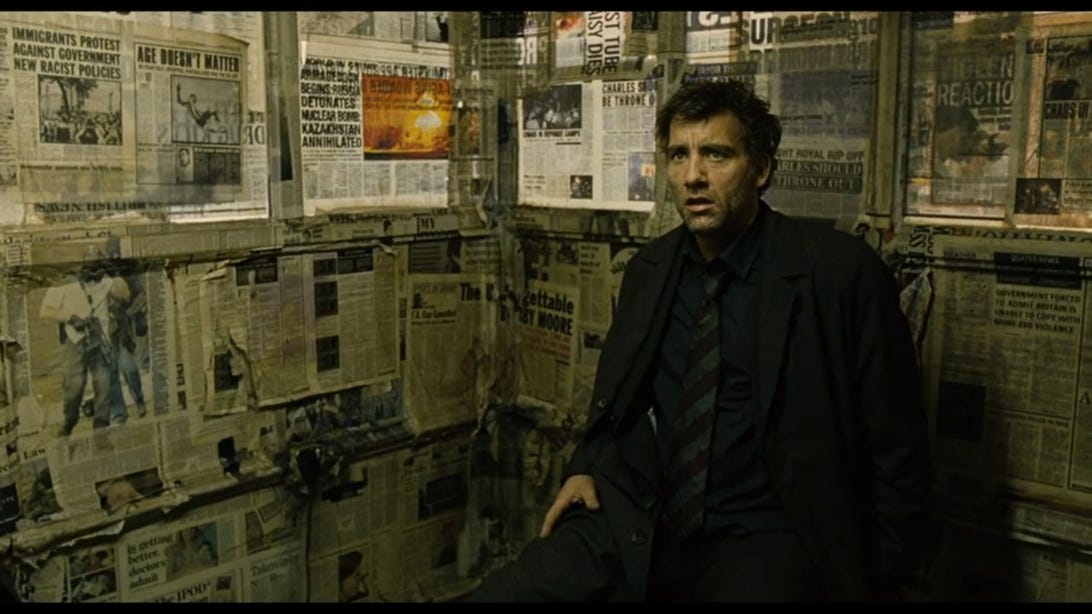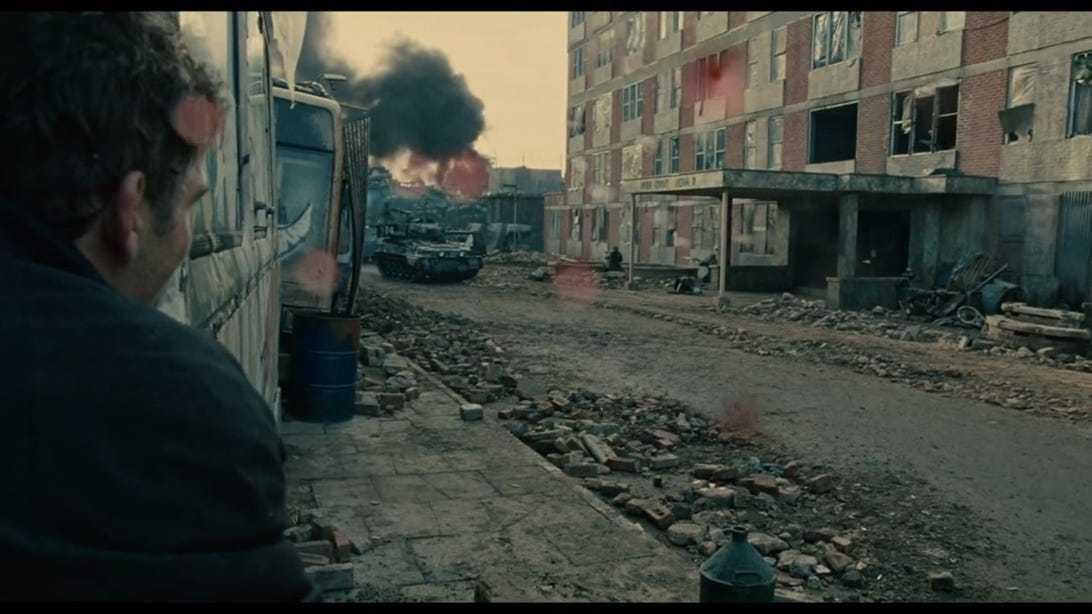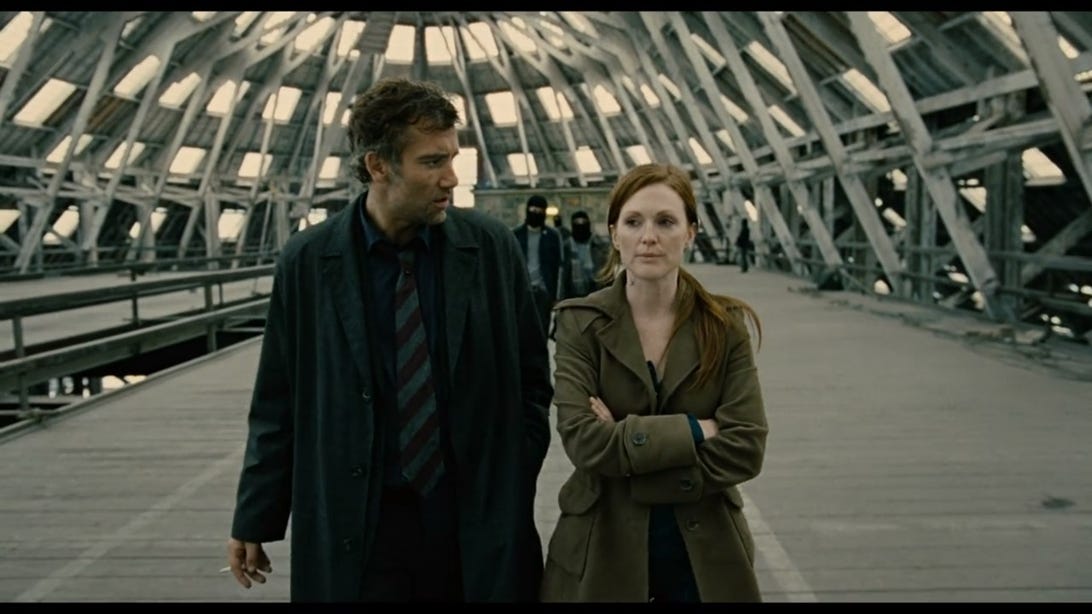
Clive Owen in Alfonso Cuarón's 2006 film, Children of Men.
UniversalYou can't read about Alfonso Cuarón's 2006 dystopian film Children of Men now without encountering the word prescient. Most people would also call it bleak.
But when I first saw it in a movie theater in 2006, I spent the entirety of the film maintaining an excruciating awareness of my future husband's knee in relation to mine. It was our first date, and the electric charge between our knees, our hands, our elbows, distracted me almost entirely from the film's unrelenting violence.
Children of Men follows Theo (Clive Owen), a jaded bureaucrat living in 2027 London after an unexplained event has caused worldwide infertility. The world has descended into chaos: Economies have collapsed, wars have broken out, terrorist bombings are almost unremarkable. The result is an unprecedented migrant crisis, with mass deportations and refugee camps that share a visual language with Holocaust films.
Theo is conscripted by his ex-wife Julian (played by Julianne Moore), a member of a militant immigrant rights group, to help transport a migrant woman, Kee (Clare-Hope Ashitey), to safety. He soon finds out why: Kee is miraculously pregnant.
"Shantih, shantih, shantih," Theo's friend Jasper (Michael Caine) says at the discovery of Kee's pregnancy. This is also famously the last line of T.S. Eliot's poem "The Waste Land," a mantra of peace amid unfathomable despair.
I had remembered Children of Men as a gritty, speculative blockbuster with better-than-strictly necessary cinematography (including the infamous blood-spattered camera lens at the film's climactic battle scene), in the same vein as The Day After Tomorrow or Deep Impact. I remembered the shaky-cam, documentary-style shots. I remembered the whimsical, John Lennon-inspired performance by Caine, and the dissonant lullaby of classical music in the soundtrack. I remembered that the revelation of Kee's pregnancy happened in a barn, a nod to there being no room at the inn.
I didn't remember how many of the main characters would be killed, or how early in the film. I didn't remember the woman carrying her own severed arm out of a bombed-out building, or the graffiti that read "Last one to die, please turn out the light," or the piles of refugees' bodies arranged in tidy rows. I didn't remember "the flu pandemic of 2008," which killed Theo and Julian's baby two decades before the events of the film.
I finished my 2021 rewatch with the speechless slow-blink of a person who has just been utterly destroyed by a work of art. My reaction 15 years later was neither articulate nor insightful: That was bleak! (And prescient.)
The final scene, imbued with unsettling ambiguity, is a bit of a litmus test for the viewer's level of pessimism. And it seems the pH level of my mental outlook has shifted quite a bit in 15 years.

In Children of Men's climactic scene, blood spatters on the camera lens to lend the film a cinéma vérité feel.
UniversalPerhaps pessimists will see bleakness. And maybe optimists will only remember that their date's soft drink was abandoned half-full, because he eventually reached over and took your hand in his. Or, maybe 2006 saw escapist sci-fi, while 2021 sees the very things we're trying to escape. Maybe hindsight is 20/20, or prescience compounds bleakness, or I was just an apolitical, privileged, lovesick teenager back then.
Or maybe a modern-day Nativity story resonates differently after your own experience of motherhood.
The quarantine
It's been 15 years since that first date, nine years since our wedding, six years since the European migrant crisis, five years since the Brexit referendum, three years since "kids in cages." It's been a year and a half since I gave birth to my first child. He got his name the same day the novel coronavirus disease became COVID-19. He is a pandemic baby, a member of Generation C, a child of quarantine, a miracle.
In the real world, the geopolitical boogeyman is not infertility, but rather the lack of governmental incentives for families, and having a baby is both quotidian and miraculous, natural and preternatural. Cultures all over the world prescribe a period of postpartum confinement for new mothers -- sometimes certain foods or hygiene activities are forbidden while the body heals -- and these postpartum traditions have an air of mysticism, like they're rooted in medicine but steeped in a spiritual reverence for human life. In Latin America, for instance, this period is called la cuarentena, the quarantine.
The quarantine of COVID-19 and that of postpartum confinement share an etymological root, a biblically inspired 40-day period of isolation. My maternity leave lasted nine weeks, not 40 days, and in my son's first few weeks of life, when we could still count the number of US deaths on one hand, I guiltily counted down to the end of my isolation, to my return to work, a return to normalcy. My time off wasn't a culturally dictated confinement period, but nevertheless I felt confined.
Your sense of time warps in maternity leave, but as in quarantine, your sense of space warps even more. The swift spread of COVID-19 around the globe has served as a stark visual of our connectedness, the meaninglessness of borders and physical distance. It strikes me that people cling tightest to borders when their insignificance is most apparent. As far as the United States' COVID-19 response, then-President Donald Trump seemed most proud of his January 2020 travel restrictions on China, but still the virus proliferated.
My own world contracted in tandem with the lockdown, as I shut out society to make room for my son's boundless needs. He became a way for me to turn inward when the doomscrolling took its toll.
The shock of parenthood was like slamming into a brick wall and waking days later with no feeling in your legs, and simultaneous disbelief you ever required legs in the first place. That, plus inexplicable joy at your newfound immobility. If this analogy doesn't make sense, it's because I'm still catching up on my sleep.

Clare-Hope Ashitey as Kee in Children of Men.
UniversalI was told repeatedly in those days that I would soon settle into a "new normal," both by fellow parents who'd traversed the path ahead of me and by the pandemic think pieces that seemed to delight in jettisoning the old normal.
Babies are born, and viruses are borne, I thought, half asleep. Surely there's a metaphor there.
As I pushed my stroller through an empty park just a few weeks after giving birth, it was the empty, caution-taped playgrounds that made the pandemic real. I didn't know then why it was this specific lockdown-era visual that did it for me. Rewatching Children of Men this year, in all its prescience and bleakness, I finally understood.
"As the sound of the playgrounds faded, the despair set in," says Kee's midwife Miriam (Pam Ferris) from an abandoned school, watching Kee swing lazily on a rickety swingset out the window. "Very odd what happens in a world without children's voices."
In the film's final frame, the screen fades to black and the soundtrack gives way to the delighted playground squeals of children: The proverbial pitter-patter of little feet, the universal shorthand for purity of joy, hope, renewal.
Does that ending insinuate Kee's baby is some sort of messianic harbinger of relief, or is it the auditory equivalent of the white light we're supposed to see just before taking our last breath? A reinstatement of normalcy, or shadows of a world that once was? Shantih, shantih, shantih.

Michael Caine as Theo's friend Jasper in Children of Men.
UniversalPrescience in unprecedented times
Choosing to reproduce is a hopeful endeavor. A statement of belief in the future, an offering of the world to a new generation, and a new generation to the world. But amid increasingly bleak climate change reports, and especially during lockdown, I've questioned the decision. It can look more like burying your head in the sand than true hope.
I found it comforting, early in the pandemic, to read about the many plagues of antiquity, because history provides proof the human race will go on. And I found it comforting during the other real-life antecedents to Theo's dystopian future -- the election of Donald Trump, the rise of anti-immigrant sentiment, the spike in gun violence -- to know mine wasn't the first generation to fear that maybe this was actually the beginning of the end. And nothing brings me relief like a veteran mom laughing about how horrible things used to be.
Prescience does compound bleakness. But if Children of Men offers an alternative reading of bleakness for optimists, there's also an alternative reading of prescience.
"This thing was not imagination," Cuarón told Vulture on the film's 10-year anniversary. He insists Children of Men is rooted in reality, a logical continuation of our current trajectory. In other words, the film does not have one foot in speculative fiction and the other in cautionary tale; it is reality through the lens of a metaphor. A parable.
The pandemic baby boom didn't pan out, and in fact there are now reports of a baby bust, with birth rates falling to a record low during our quarantine year. Every time I've heard pessimistic birth rate reports and predictions like these in the past 15 years, I've thought of Children of Men. And a small, almost absentminded seed of anxiety germinated in me ever since.
The problem with population decline is economic -- a dwindling labor force, diminished innovation. And the solution offered by economists is not always rooted in simple pronatalism. The solution is immigration.
In The Children of Men, the P.D. James novel on which the film's screenplay is based, the miracle baby is Julian's, not Kee's, and that discrepancy is an important one if we're trying to reframe the film's prescience. Kee is a young African refugee, not an English citizen, and her mere existence is both illegal and utterly crucial.

Clive Owen and Julianne Moore as Theo and Julian in Children of Men.
Universal"Poor fugees -- after escaping the worst atrocities and finally making it to England, our government hunts them down like cockroaches," says Jasper, in one of the film's most prescient lines.
The decision to recast the Virgin Mary character as an immigrant seems important now because it makes me see the film less as a warning and more as a proposed solution -- a solution floated on a rising tide that lifts all boats. It is only when packaged with hope that prescience attempts to problem-solve.
Shantih, shantih, shantih
When people find out about my and my husband's first date now, 15 years later, they are often surprised to hear we began under the auspices of one of the bleakest dystopian films in recent memory. But I remember leaving the theater with the giddy anticipation of things to come.
The most exciting part of a new relationship is not knowing what the future will bring, the delicious, heart-leaping uncertainty that hasn't yet been paved over with intimacy. Intimacy is boring; it kills the butterflies in your stomach. But intimacy has its own magic that's hard to describe: It is knowing what your partner is going to say, trusting he'll stay with you, not bothering to close the bathroom door while you floss your teeth.
In the same way, dispatches from parenthood fail to convey the transcendent joy of hearing your child's laughter or watching his face light up at the novelty of everyday life. And so, maybe hope is not an ignorance of warnings, but a faith in solutions -- capitulating to a future whose promises are there, just not quite legible.
It's been 9 years since the London Olympics on Theo's threadbare sweatshirt, 12 years since the youngest child in his world was born, 13 years since the fictional flu pandemic that took his son, 15 years since the film's theatrical release, 20 years since the trauma of 9/11 kindled Cuarón's creative inspiration for the project, 99 years since the "new normal" following the utter decimation of World War I that inspired T.S. Eliot's Shantih, shantih, shantih. There are 6 years until the events of the film unfold.
Why the preoccupation with time? Children of Men exists strangely in the past, present and future all at once, a relic of the mid-aughts with alarming 2021 prescience and a 2027 setting. Maybe we can all breathe a sigh of relief when we reach 2028 and babies still exist. But Cuarón is no fortune teller, and James' novel is set in, of all years, 2021.
Movies coming in 2021 and 2022 from Netflix, Marvel, HBO and more
See all photoshttps://ift.tt/3zMSbn8
Technology

No comments:
Post a Comment